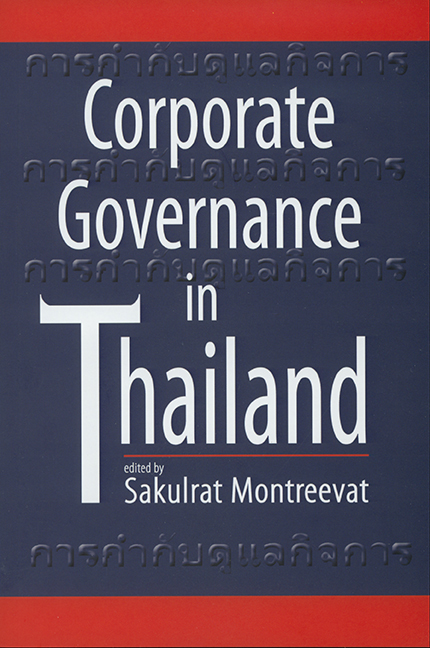Book contents
- Frontmatter
- Contents
- List of Tables
- List of Figures
- List of Abbreviations
- Acknowledgements
- Contributors
- Introduction
- 1 Transparency and Accountability of Listed Non-Financial Companies in Post-Crisis Thailand
- 2 Good Governance in the Thai Banking System
- 3 Corporate Governance among State-Owned Enterprises in Thailand
- 4 Thai Company Laws and Good Governance Practices of Unlisted Companies
- Concluding Remarks
- Index
1 - Transparency and Accountability of Listed Non-Financial Companies in Post-Crisis Thailand
Published online by Cambridge University Press: 21 October 2015
- Frontmatter
- Contents
- List of Tables
- List of Figures
- List of Abbreviations
- Acknowledgements
- Contributors
- Introduction
- 1 Transparency and Accountability of Listed Non-Financial Companies in Post-Crisis Thailand
- 2 Good Governance in the Thai Banking System
- 3 Corporate Governance among State-Owned Enterprises in Thailand
- 4 Thai Company Laws and Good Governance Practices of Unlisted Companies
- Concluding Remarks
- Index
Summary
Transparency in reporting information to the public and accountability to the public for its activities are very important for good corporate governance. After the Asian financial crisis in mid-1997, there was much discussion and numerous activities launched to improve corporate governance in Thailand, especially for companies listed on the Stock Exchange of Thailand (SET). This chapter reviews the development of corporate governance in Thailand and identifies the significant players involved in promoting corporate governance. It also looks at voluntary and regulatory approaches towards good corporate governance, along with possible policy recommendations. However, the scope of this study covers the listed non-financial companies only. Two actual cases representing the worst and best of corporate governance practices in post-crisis Thailand are also provided.
The Development of Corporate Governance
Even before the financial crisis of 1997, some firms in Thailand were already practising varying degrees of corporate governance. For instance, Siam Cement Public Company Limited, the largest building and construction conglomerate, adopted the code of best practices that IBM Thailand Company Limited adhered to. In 1996 the SET commissioned Price Waterhouse Management Consultants Limited to conduct the first survey to find out how Thai companies fared with regard to corporate governance. The data gathered from the survey would then be used to help Thailand develop its capital market.
An analysis of the financial crisis in July 1997 reveals that structural weaknesses in the Thai economy had allowed massive capital inflows into the economy. The problem was worsened by the lack of proper macroeconomic management mechanisms, coupled with bad corporate governance among companies that do not observe the separation of management and control. Moreover, reckless lending was prevalent at the time and loan growth was almost the only factor that financial institutions focused on. It was therefore not surprising that most corporations invested heavily using the foreign capital inflows that passed through the local financial institutions. At the same time, there was a lack of accountability and transparency in the expropriation of funds.
- Type
- Chapter
- Information
- Corporate Governance in Thailand , pp. 1 - 27Publisher: ISEAS–Yusof Ishak InstitutePrint publication year: 2005



